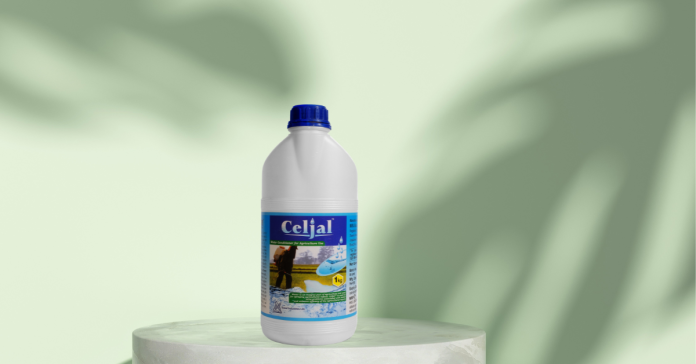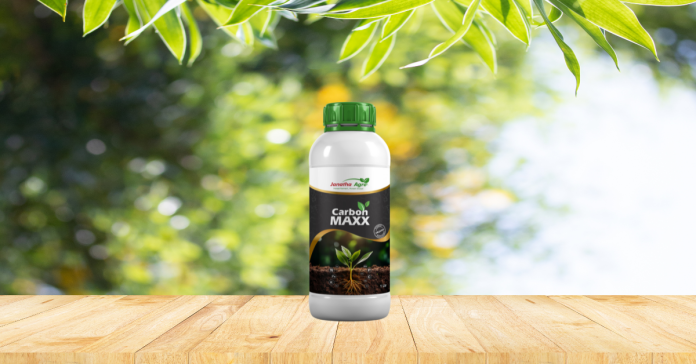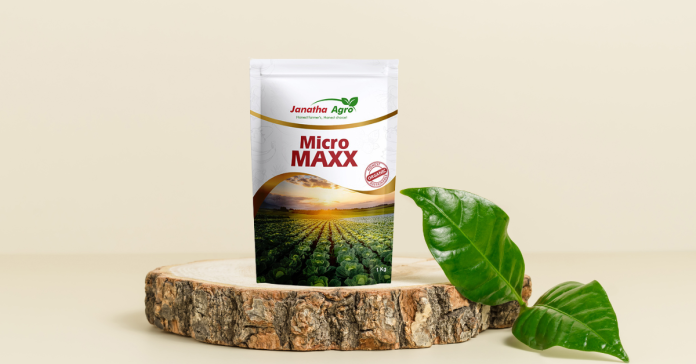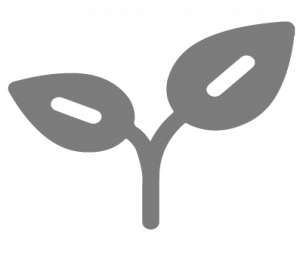Carbon Maxx is a marine-based plant nutrient enriched with high levels of dissolved protein hydrolysates, amino acids, essential minerals, organic carbon, and micronutrients. It nourishes plants without causing burn, enhances soil structure, and boosts nutrient uptake. Carbon Max supports rapid plant growth, healthy foliage, and strong root development. It increases soil microbial activity, promotes chlorophyll, sugar, and amino acid production, and improves yield and quality. It also enriches the soil with nutrients and provides food for earthworms and other microorganisms, which enhances the soil’s structure and nutrient uptake.
Coconut Palm
Coconut plant (Cocos nucifera) is a vital tropical crop known for its tall, slender trunk and crown of long, green leaves. Originating from the Indo-Malaya region, it produces coconuts with edible flesh, coconut water, and oil-rich copra. Thriving in warm, coastal climates, coconuts are essential for their nutritional, economic, and cultural significance. They are integral to many cultures and industries worldwide.
Major Growth Stages of Coconut palm
- Vegetative stage
- Reproductive stage
- Nut formation stage
Crop Management with Carbon Maxx at various stages of Coconut palm
-
Vegetative stage
During the vegetative growth stage, the coconut plant focuses on developing its structural components, such as leaves, stems, and roots. This stage begins after the sapling phase and can last for several years. The trunk thickens, and the crown of the tree expands as new fronds emerge. The plant directs its energy towards growing taller and stronger, rather than producing flowers or fruits. Adequate water, nutrients, and sunlight are crucial during this period to support robust growth and prepare the plant for the subsequent reproductive stage.
2. Reproductive stage
The reproductive stage in coconut plants begins when they start flowering, typically around 5 to 7 years after planting for tall varieties, and 3 to 4 years for dwarf varieties. During this stage, the plant produces both male and female flowers in the same inflorescence. Pollination occurs primarily through wind and insects, leading to the development of coconuts. Once pollinated, the female flowers develop into mature coconuts over a period of about 11-12 months. Proper care, including adequate water and nutrient supply, is crucial during this stage to ensure healthy fruit development and maximize yield.
3. Nut formation stage
The nut formation stage in coconut plants begins after successful pollination of the female flowers. Initially, the young coconuts start to grow in size, with the cavity inside the nut differentiating and filling with coconut water by the second month. By the seventh month, the cavity reaches its maximum size, and a thin layer of raw kernel starts to form. As the nuts continue to mature, the kernel thickens and hardens, while the amount of coconut water decreases. This stage is crucial for the development of high-quality coconuts, requiring adequate water and nutrient supply to ensure optimal growth and maturation
Product usage in Coconut palm
- Promotes healthy foliage and leaf canopy development: Encourages robust growth of leaves and overall plant structure.
- Promotes development of chlorophyll, sugars, and amino acids: Enhances photosynthesis and overall plant health, increasing yield and quality.
- Increases soil microbial activities and boosts the biological processes in the soil.
- Improves soil structure, loosens soil for easier root penetration and helps with water retention.
- Boosts nutrients in the soil: Restores biological balance, ensuring plants have access to essential nutrients.
- Improves inflorescence and nut formation: Enhances nut setting, leading to higher yields of superior quality coconuts.
- Application: Use Janatha Carbon Maxx at 1 liter per acre of water or 1-2 liters per acre for drip irrigation. Frequent application throughout the cropping cycle is recommended for optimal results.
- Frequent application throughout the cropping cycle is recommended for optimal results.
Banana Crop
In the heart of Southeast Asia, the story of the banana (Musa spp.) begins. These vibrant fruits, journeying through centuries, found new homes across the globe, including the Americas in the 1500s. Banana plants are truly nature’s marvels, thriving in diverse climates. Nutritional powerhouses, they are packed with energy, fiber, potassium, and vitamins B6 and C. Whether enjoyed as sweet, creamy dessert bananas or hearty, versatile plantains, they are a dietary staple worldwide. Effective nutrient management is crucial for optimal growth, and tailored fertilization strategies, such as using Janatha Carbon Maxx, can significantly enhance crop development and yield.
Major Growth Stages of banana crop
- Vegetative stage
- Flowering stage
- Fruit development Stage
Crop Management with Carbon Maxx at various stages of Banana
-
Vegetative stage
Vegetative stage of a banana plant is crucial for its growth and productivity, lasting about six months. During this phase, the plant focuses on producing large, broad leaves and establishing a strong root system. Adequate water and nutrient supply are essential to support this rapid growth. Proper care during this stage, including tailored fertilization strategies, sets the foundation for successful flowering and fruiting later on.
2. Flowering Stage
Flowering stage of a banana plant begins around 9 to 15 months of age and marks the transition from vegetative growth to reproductive growth. The inflorescence emerges from the pseudostem, with female flowers at the top developing into bananas and male flowers below. This stage can last several months. Proper nutrient management is crucial for healthy flower and fruit development.
3. Fruit stage Stage
The fruit stage of a banana plant begins after flowering and typically lasts about 2 to 3 months. During this period, the bananas develop and mature, growing in large bunches called hands, with each hand containing up to 20 bananas. Proper nutrient management is crucial to ensure healthy fruit development and maximize yield. Once the bananas reach maturity, they are harvested while still green and allowed to ripen off the plant. The time it takes to harvest a banana plant depends on the variety and growing conditions, but it’s usually between nine and 12 months.
Product usage in Banana crop
- Carbon Max is essential for banana crop nutrient management, supporting rapid plant growth and healthy development of foliage and fruit.
- It promotes strong root development and increases soil microbial activities, enhancing soil structure and water retention.
- By boosting chlorophyll, sugars, and amino acids, it improves yield and quality.
- Carbon Max also loosens soil for easier root penetration and restores biological balance, ensuring optimal nutrient uptake.
- Apply 1-2 liters per acre via drip or flood irrigation, Frequent application is recommended.
- Carbon Max is suitable for all types of crops, including plantation, fruit, and flower crops.
Arecanut Palm
The arecanut palm, also known as betel nut palm, is a significant tropical crop valued for its seeds, widely chewed in many cultures. Originating from Southeast Asia, it thrives in warm, humid climates and is integral to the agricultural economies of regions like India, particularly in Karnataka, Kerala, and Assam. Effective nutrient management is crucial for its growth and development. This ensures healthy development, higher yields, and sustainable cultivation practices.
Major Growth Stages of Arecanut Palm
- Vegetative stage
- Reproductive stage
- Nut formation stage
Crop Management with Carbon Maxx at various stages of Banana
-
Vegetative stage
Vegetative stage of the arecanut palm is crucial for its growth and productivity. This phase begins after the seedling stage and can last several years. During this period, the plant focuses on developing its structural components, such as leaves, stems, and roots. The trunk thickens, and the crown expands as new fronds emerge. Adequate water, nutrients, and sunlight are essential to support robust growth. Proper care, including regular irrigation and fertilization, sets the foundation for the plant’s subsequent reproductive and nut formation stages.
2. Reproductive Stage
Reproductive stage of the arecanut palm begins when the plant starts flowering, typically around 4 to 6 years after planting. During this stage, the palm produces both male and female flowers in the same inflorescence. Pollination, primarily facilitated by wind and insects, leads to the development of arecanut seeds. This stage is crucial for fruit set and nut formation, which can take several months to mature. Proper nutrient management is essential to support healthy flower and nut development, ensuring high yields and quality nuts.
3. Nut Formation Stage
Nut formation stage in the arecanut palm begins after successful pollination of the female flowers. Initially, the young nuts start to grow in size, with the kernel developing inside. This stage involves a rapid increase in size during the first phase, followed by volume and dry matter accumulation in the kernel during the second phase. The embryo becomes macroscopic and develops rapidly. This stage is crucial for producing high-quality nuts, requiring nutrient supply to ensure optimal growth and maturation. Proper care and management during this period are essential to maximize yield and quality.
Product usage in Arecanut
- Carbon Max is essential for arecanut crop nutrient management, supporting rapid plant growth and healthy development of foliage and nuts.
- It promotes strong root development and increases soil microbial activities, enhancing soil structure and water retention. By boosting chlorophyll, sugars, and amino acids, it improves yield and quality.
- Carbon Max also loosens soil for easier root penetration and restores biological balance, ensuring optimal nutrient uptake.
- Apply 1-2 liters per acre via drip or flood irrigation. Frequent application is recommended.
Conclusion
Power of Janatha Carbon Maxx to transform your coconut, banana, and arecanut palms into thriving, productive wonders. This nutrient-packed marvel fuels robust vegetative growth, boosts inflorescence and nut formation, and enriches soil structure and microbial life. Bountiful harvests of superior quality crops. Consistent use of Carbon Maxx is your secret to unlocking the full potential of your plants, ensuring they flourish at every stage of growth.










